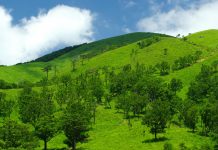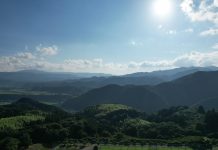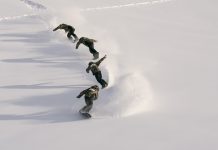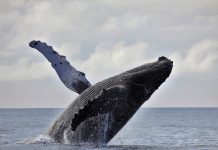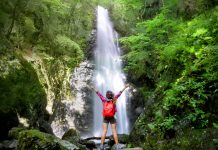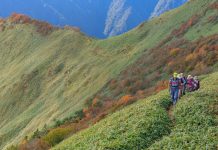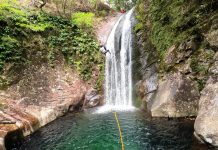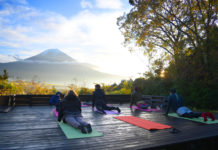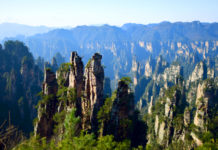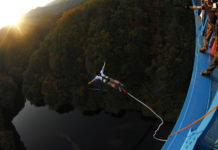Long before spandex-clad hard bodies began blazing mountain trails, the Hash House Harriers were chasing each other through hill and dale and having a blast doing it.
Trail running is currently experiencing a boom of sorts, as many people are choosing to ditch the pavement and enjoy the outdoors more. The Hash House Harriers, or “Hash” for short, has a long history of trail running—nearly 70 years—and its fair share of pavement-pounding depending on the locale, which includes several groups in the Land of the Rising Suds….ah Sun.
What is the Hash exactly? “It’s a place where you meet people from all walks of life who share at least one similar interest: to run an interesting course at their own pace and not be ridiculed for it—and then get deliciously drunk.” says “Slimie Limie,” a British ex-pat living near Osaka (not his real name, most members are giving a “Hash Name” after a few runs).
The club is open to anyone with a sense of humor, regardless of fitness level or social standing. As “Snow White,” a British ex-pat working as an architect in Tokyo, points out, “Everyone, from waitresses to CEOs, looks the same in running shorts.”
“Hiragana,” an older Japanese dentist, philosophically adds, “People love to drink, get together and communicate. That is very essential.”
Running is a very human endeavor. Our hunter-gatherer ancestors were always on the run trying to catch prey, and it is still in our genes. This innate desire to run makes the progression for any new runner, couch potatoes and weekend warriors alike, quite rapid. The Hash has introduced running to thousands of people around the world, yours truly included.
“Kim Jong-Poo,” a Japanese translator, adds, “the Hash has given me more opportunities to join other activities such as the Oxfam Trailwalker and snowshoeing.”
The club originated in 1938 in Kuala Lumpur when a group of British ex-pats decided they needed to do a little exercise to make up for all the drinking they did on weekends (they met on Mondays, see sidebar for more on the History of the Hash).
The Hash took off in Japan June 4, 1976, when Hong Kong hasher “Dunafew,” laid the first trail in Kichijoji, Tokyo. On Jan. 9, 1978, after being transferred to Kobe, he started the Kobe H3, and both groups have been hashing ever since. There are now Hashes in many large cities in Japan and around most American military bases. Some meet every week or every month, others on full moons—or even every four years on Feb. 29.
Today there are kennels in all major and many minor cities of the world. GTHHH.com has more than 1,800 kennels in 178 countries registered in its database. This is ideal when traveling, as the Hash provides you with an instant group of friends around the world, wherever you travel.
“They will show you places no tourist will ever see and steer you clear of any place that may try to take advantage of your tourist status,” adds “Three Dogs F***ing,” an American teacher living near Hiroshima.
From Argentina to Luxembourg, Malaysia to Zimbabwe, just type in where you are going to “HHH” on a search engine, and you are bound to find a group
.
The Hash also has special events, such as national Hashes (the next one in Japan is coming this May in Okinawa), continental events and even a world “Inter-Hash” that occurs every other year. In 2008 the event takes place in Perth, Australia. These larger events attract hundreds or thousands of people and are a great way to discover less frequented parts of popular tourist destinations.
Typically, Hash trails are between 5 and 10 km. (depending on the kennel) through varied terrain such as jungles, Antarctic snow fields, shopping malls, small alleys, quiet temples and even the reddest-light district. Hashers run anywhere and everywhere.
Not unlike orienteering, the trail also contains a number of “checks,” where faster runners scurry in all directions to find the true trail. This allows the pack to stay together.
“Ghost Ride Her,” an American marine who founded two kennels, including the Fallujah H3 “where every run is a blast,” mentions, “You don’t have to run the trail, but it will get you to the beer faster.”
To the beer, you say? Yes, beer. The nectar of the gods can inevitably be found at the trail end. The club isn’t called “a drinking club with a running problem” without reason. Of course non-alcoholic beverages are also provided, but for most hashers, nothing tastes better than a beer after running.
After the last members come back from the trail, things get interesting as the “Circle” is formed. During the ceremony, the hares, newcomers, visitors, people celebrating anniversaries, owners of new shoes and so on, are celebrated with a serving of beer and the singing of bawdy chants, often borrowed from rugby songs.
The Hash is not serious running, but it is serious fun. It can easily be added to your training schedule whether you are planning a marathon or just want to get a little more exercise. A word of warning, though; hashing can be addictive. Should you start hashing to get in better shape for your favorite sport, you may find yourself slowly abandoning your old flame for a new one.
WEB CONNECTION
Hashing in Japan: www.kobehash.com/hashlist.htm.
World Wide Hashing: www.GTHHH.com



